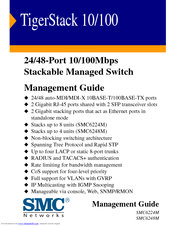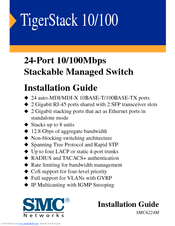SMC Networks 8724M INT - annexe 1 Manuals
Manuals and User Guides for SMC Networks 8724M INT - annexe 1. We have 3 SMC Networks 8724M INT - annexe 1 manuals available for free PDF download: Management Manual, Installation Manual
SMC Networks 8724M INT - annexe 1 Management Manual (592 pages)
SMC Networks Gigabit Ethernet Switch Management Guide
Brand: SMC Networks
|
Category: Switch
|
Size: 6 MB
Table of Contents
-
-
-
Main Menu61
-
-
-
-
-
Command Usage117
-
Radius Settings118
-
TACACS Settings119
-
Field Attributes126
-
-
-
-
Table191
-
-
Field Attributes196
-
Command Usage200
-
Each Port215
-
Spanning Tree217
-
-
-
Creating Vlans227
-
Command Usage233
-
-
-
-
-
Command Usage255
-
-
Advertisement
SMC Networks 8724M INT - annexe 1 Management Manual (522 pages)
TigerStack 10/100 24/48-Port 10/100Mbps Stackable Managed Switch
Brand: SMC Networks
|
Category: Switch
|
Size: 5 MB
Table of Contents
-
-
-
Main Menu59
-
-
Command Usage105
-
-
-
-
-
Field Attributes182
-
Command Usage186
-
-
Creating Vlans205
-
Command Usage211
-
Private Vlans214
-
-
-
Command Usage239
-
SMC Networks 8724M INT - annexe 1 Installation Manual (83 pages)
TigerStack 10/100 24-Port 10/100Mbps Stackable Managed Switch
Brand: SMC Networks
|
Category: Switch
|
Size: 1 MB
Table of Contents
-
-
Overview21
-
-
-
Connectivity28
-
Performance28
-
Management29
-
-
-
-
-
Mounting40
Advertisement


